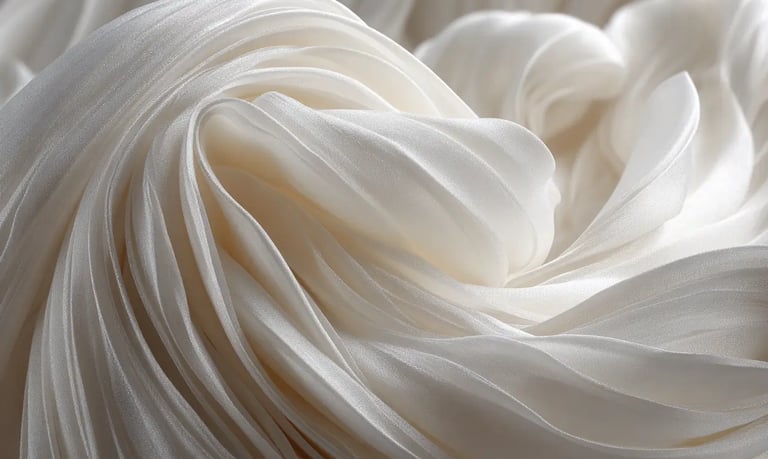Lab-Grown Materials in Fashion: The Future of Sustainable Clothing or Just Hype?
CONSUMERISMSUSTAINABILITYINNOVATION


The fashion industry is notorious for its environmental impact, with concerns ranging from excessive water use to harmful chemical processes. But as sustainability takes center stage, fashion futurists are betting on a new generation of materials—lab-grown textiles. These innovative materials promise to transform the way we create and consume clothing, offering potential solutions to long-standing environmental and ethical issues. But are they truly the future of fashion, or is it all just hype? Let’s dive into the world of lab-grown fabrics and explore their potential, challenges, and what it means for the future of the fashion industry.
What Are Lab-Grown Materials?
Lab-grown materials are textiles created through biotechnological processes rather than relying on natural resources. These materials are developed in controlled environments, using biological methods to mimic the qualities of traditional fabrics. Examples include lab-grown leather, spider silk, and cotton—materials that could change the way we think about fashion production and consumption.
By replacing resource-intensive farming and animal-based industries, lab-grown fabrics aim to provide more sustainable and ethical alternatives without compromising on quality or performance.
The Promise of Lab-Grown Fashion
Several breakthroughs in lab-grown materials are already making waves in the fashion world, and the buzz around them is hard to ignore:
Lab-Grown Leather: Traditional leather production is resource-heavy, involving cattle farming, water usage, and animal cruelty. Lab-grown leather, created using plant proteins or even animal cells, offers a cruelty-free alternative. Major brands like Stella McCartney are already experimenting with lab-grown leather for handbags and shoes, providing a sustainable, animal-free option.
Spider Silk Fabric: Spider silk is renowned for its strength and elasticity, but it’s difficult to harvest in nature. Lab-grown spider silk, produced through the fermentation of yeast, bacteria, and fungi, offers a more scalable alternative. Brands are exploring its use for everything from luxury garments to high-performance athletic wear.
Mycelium Leather: Made from the root structure of mushrooms, mycelium leather is biodegradable, versatile, and sustainable. Companies are experimenting with mycelium to create durable fashion accessories such as shoes and bags, and it’s rapidly gaining popularity as a viable alternative to traditional leather.
Lab-Grown Cotton: Cotton farming is a significant environmental issue, with water consumption and pesticide use at the forefront. Lab-grown cotton, grown from cells in a lab, could offer a more efficient, resource-conscious way to produce fabric, reducing the need for land and water.
Why Lab-Grown Materials Are Gaining Traction
There’s a lot to love about lab-grown materials, especially when it comes to their potential environmental and ethical benefits:
Sustainability: Traditional textile production often leads to large-scale environmental damage. Lab-grown materials use fewer resources, reducing water, land, and energy consumption. For example, lab-grown leather uses far less water than cattle farming and doesn't require deforestation or harmful chemicals in its production.
Animal Welfare: Lab-grown materials provide cruelty-free alternatives to traditional textiles like leather and silk. Lab-grown leather, in particular, addresses the growing demand for ethical fashion choices while offering the same look and feel as animal-derived products without harming any animals.
Waste Reduction: By using biological processes, lab-grown materials have the potential to cut down on textile waste. Unlike traditional leather production, where up to 60% of the raw material can end up as waste, lab-grown options can be created to order, resulting in minimal waste during production.
Innovation in Design: Lab-grown materials can be custom-designed to meet specific needs, such as strength, flexibility, or texture. This opens the door to exciting design possibilities that are currently unattainable with traditional fabrics.
The Challenges to Overcome
Despite their exciting potential, lab-grown materials face several challenges that must be addressed before they can become mainstream:
Cost and Scalability: Lab-grown materials are still relatively expensive to produce, especially when it comes to scaling up manufacturing. While the technology is advancing, it’s currently not cost-competitive with mass-produced, traditional fabrics. As demand increases and production methods improve, costs will likely decrease, but for now, affordability remains a challenge.
Energy Consumption: The processes required to create lab-grown materials, such as spider silk or leather, can be energy-intensive. To truly be sustainable, these production methods need to use renewable energy sources. If not managed carefully, the environmental benefits of lab-grown materials could be offset by high energy use during production.
Consumer Acceptance: While sustainability-conscious consumers are eager to adopt lab-grown alternatives, many shoppers still prefer the familiarity of natural materials like cotton, wool, and leather. Overcoming the stigma around synthetic or lab-grown fabrics and educating consumers about their benefits will be key to gaining widespread acceptance.
Standardisation: As the market for lab-grown materials grows, there will need to be clear standards and certifications to ensure the sustainability and ethical claims of these fabrics. Without transparency, it could be difficult for consumers to discern which products are truly eco-friendly.
The Bottom Line: Is the Hype Real?
Lab-grown materials offer an exciting glimpse into the future of fashion, with potential to drastically reduce the environmental and ethical issues that have plagued the industry for decades. However, we’re not there yet. The technology is still developing, and while the possibilities are vast, challenges such as cost, scalability, and energy consumption need to be addressed.
As consumers, it’s important to remain open-minded but also critical. Lab-grown materials are definitely worth watching, and over time, they could become a mainstream part of the fashion landscape. But, like any emerging technology, it will take time for the benefits to fully materialise.
For now, it's worth supporting brands that are experimenting with lab-grown materials, as their efforts are pushing the fashion industry towards a more sustainable future. Whether lab-grown textiles will completely replace traditional materials remains to be seen, but one thing is clear—this is a revolution worth paying attention to.


